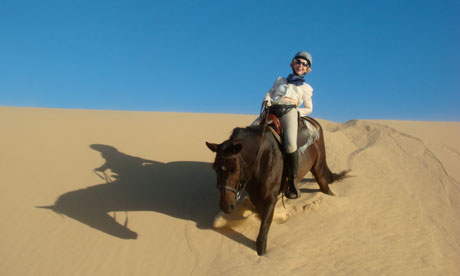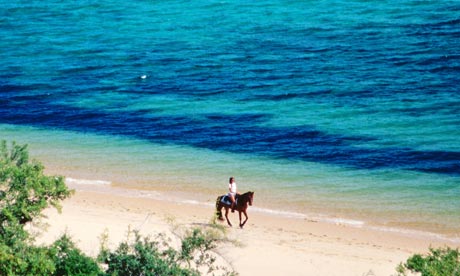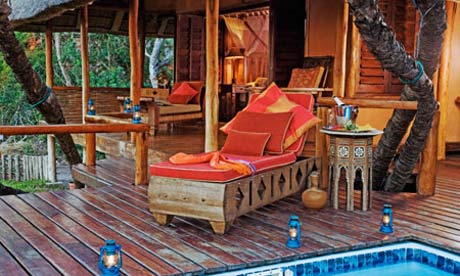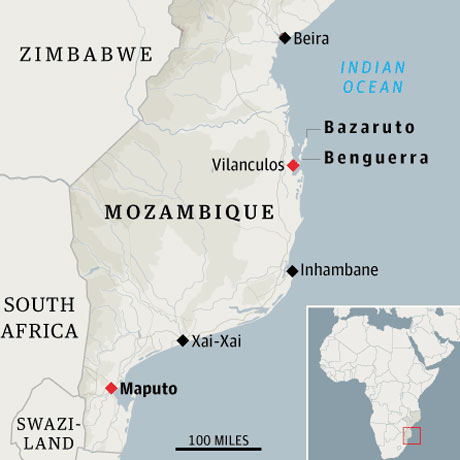Story by Kate Kellaway -- first published in The Guardian, Saturday 11 June 2011

Horse play … Kate Kellaway in Mozambique
Two years ago, I received an email from a woman called Amanda Retzlaff. Her story sounded extraordinary: she and her husband had fled Robert Mugabe's Zimbabwe with 104 horses which they had rescued during the land invasions and taken across the border to Mozambique. They were trying to piece together a new life and start a riding holiday business from scratch. Would I like to come and visit? I told her there was little chance of my getting there – but held on to her email.
I had reasons of my own, aside from the riding – which sounded fantastic – for being interested. I had taught in Zimbabwe in the 1980s and been curious about neighbouring Mozambique which, at that time, was more or less unvisitable. Independent from Portugal since 1975, it was in the grip of civil war (between the Renamo resistance movement and the Marxist Frelimo, the Liberation Front of Mozambique). I tried to forget about Amanda's invitation. But at the beginning of this year, I realised I could hold out no longer: I had to swap my armchair for a saddle.
The Retzlaffs met me in the last week of March in the tiny, shambolic (though being expanded and refurbished) airport of Vilanculos – a seaside resort 750km north of Maputo. They are what my grandmother used to call "real people". Mandy is warm, talkative, good company. Pat is quieter and a fine horseman: he makes his own saddles, shoes his horses and escorts all the rides.
They had been farmers in Zimbabwe. In time, I would find out more. But at first, I wanted to hand over the gifts I'd brought – honeyed horse treats, a spare riding hat and, at Mandy's request, a DVD of the award-winning documentary Mugabe and the White African. This film, which they had not seen, is the harrowing account of white farmers – friends of theirs – who were beaten up on their farm by war veterans in Mugabe's "Land Reform", went to court about it, and won, but later lost everything when their farms were burned to the ground.
Mozambique, unlike Zimbabwe, is uncontroversially peaceful now. I spent the first night in Archipelago Lodge, a resort of self-catering chalets on the ocean south of Vilanculos, where you feel you could easily run into Babar and Celeste, the elephants from Laurent de Brunhoff's stories. Each chalet is spacious, with a thatched roof and a view of the Indian ocean.

Riding by the Indian Ocean. Photograph: Alamy
It is a serene, reasonably priced base for a Vilanculos riding holiday. Mandy and Pat are open to riders of all abilities and can customise rides. (It is too hot to ride all day – two to three hours at a stretch feels right.) They proposed riding out on the afternoon I arrived. And that ride was a revelation.
The beaches of Vilanculos are wide – they go on forever when the tide is out – and bordered by mangrove swamps and the Indian ocean. I ride regularly and have had several holidays on horseback, but Mozambique has to be the most outstanding beach riding destination. I have never been allowed such freedom on a horse holiday. Here we were not herded or bossed, though Pat was mindful of safety. He might say, "Canter up to the yellow boat," or,"Stop at the big rock" – which was a small speck on the horizon. The atmosphere was personal, ad hoc and magical. The heat was intense but there was a constant breeze coming off the sea. The silk on my hat kept threatening to blow away.
The sea, in many variants of turquoise, was calm, though it rushed into the mangroves at speed. I had forgotten how the African sunlight transforms everything. And nothing could be more wonderful than speeding along the sand past egrets, herons, a solitary ibis. You might dodge a bed of shells, a rock or the rope securing a fishing boat but otherwise there were no obstacles. We rode along the north beach and up a red dune to a place nicknamed Fingerprint of God. God, I observed, seems to have had his hands all over this place.
In Mozambique, everything happens in its own time. There is a saying that in the west we have money; in Mozambique, they have time. The truth is that Mozambique needs our money: its tourist industry has huge potential but the country is still (blessedly for visitors) under-visited. And it is perhaps also true that we need its time. My timetable involved nothing more challenging than leaving Vilanculos for a 20-minute boat trip to the bewitching Bazaruto archipelago.
First stop was Benguerra island, 14km from the mainland, where half a dozen of Pat and Mandy's horses live and where rides are overseen by Lucy Campbell Jones, an engaging Englishwoman who first came to Mozambique as a volunteer.
The plan was to sample the varied pleasures of Benguerra and neighbouring Bazaruto islands. My life has not featured many luxury hotels but I adjusted with indecent speed to Benguerra Lodge and to being waited upon by the Byronic Sergio in his floor-length white gown and scarlet cummerbund. There was no resisting his ability to produce iced tea at the double, summon a dhow or string up a shady hammock.
When I lay in the hammock, I reasoned that everyone deserves to visit this country once. I walked down from Benguerra Lodge to a barbecue on the beach one night, where a fire was burning and its smoke, driven by breeze, poured out horizontally – it reminded me of our beach riding as it vanished rapidly alongside the sea.
The riding on Benguerra is out of this world: the horses are safe, well-schooled and fit. One late afternoon, Lucy and I cantered along the beach and trotted inland past beautiful freshwater lakes where there were cashew nut trees (the toxic husks are used to brew liquor), wild orange trees and gatherings of flamingos.

Benguerra Lodge. Photograph: Alamy
On Benguerra, I was introduced to non-riding pursuits too: fishing and snorkelling. I think of fishing as a wait at the edge of a dreary English pond and had not realised it could be so active. At one thrilling moment, guided by expert fisherman Graham Pollard, I caught a ladyfish which, with unladylike athleticism, promptly flung herself back in the sea. At another, I hauled in satisfactorily – with help – a majestic green spot trevally. From the boat, we saw several dolphins and a turtle (I was thrilled to catch its beady eye on camera). Sometimes it is also possible to see humpback whales and dugongs in these waters.
The next day, I went snorkelling above a coral reef and was entranced by the shoals of parrotfish, the finest of which was maroon with traces of gold – like swanky hotel upholstery (an escapee from Benguerra Lodge?). I also saw powderblue surgeonfish and goatfish – white with inky dark spots. I could not believe how unfazed the fish were – as if we were of their company, just larger and more cumbersome, with our rigid flippers.
I stayed one night in the immaculate, modern Marlin Lodge (also on Benguerra) where I was treated to a memorably over-the-top "bush bath" scattered with hibiscus petals in an outdoor playpen made of palm leaves. At Marlin Lodge, they toss their flowers about freely – like confetti for the many ecstatic honeymooners who fetch up there.
I spent another night on Bazaruto island, a mile or two north, at Indigo Bay – a magisterial hotel for those who prefer not to give modern life the slip altogether (air-con, computer room and, a rarity in Mozambique, sparkling mineral water). But what I most enjoyed was an outing with Indigo Bay's Mozambican horseman Domingo, who took me up a 100m sand dune called the Pelican. Going up was easy enough but then I had to descend an almost vertical sandy slope. It seemed impossible, but I just had to trust that the horses knew what they were doing (and they did).
Back on the mainland in Vilanculos, I decided the time had come to find out more about Mandy and Pat. I already knew their story had not been one of five-star luxury. They were victims of the 2001 trashing and looting of farms in Zimbabwe's Chinhoyi district. As the land invasions spread, thousands of horses were abandoned on the farms, or destroyed.
Many veterinary surgeons, depressed by the relentless slaughter, left the country altogether. Pat and Mandy took in horses from miles around. Some were in a sorry state. One had a war vet's spear piercing her withers – a wound that took two years to mend. ("I could stick my fist through her back," Pat says).
The Retzlaffs moved from one leased farm to another as the land invasions intensified. Often, they would have to pack up and move on in less than four hours. Along with most of Zimbabwe, they hoped Morgan Tsvangirai would win the presidential election: "It would have been light at the end of the tunnel."
After their sixth eviction, they moved to Mozambique, by which time, they had to acknowledge, the horses were becoming "a huge burden".
Mandy was starting to panic: "What on earth are we going to do with all these horses?"
Pat replied: "We are going to start a horse safari."
He took his horses off the truck at 4pm one day and was taking guests on rides the next morning: "I went up the beach, and found a few paths. The customers loved it."
And the horses themselves were "delighted by beach life – as though they were on holiday". It was then that Pat realised he had "never ridden anywhere as beautiful".
But on 22 February 2007, two months after they'd settled into this new life, disaster struck: a cyclone flattened Vilanculos: "We didn't get a single customer for six months."
Did they think then of giving up?
"No, because the horses had become part of our lives. There was no question of deserting them."
They got by, with help from volunteers from overseas. (It is hard to imagine a more brilliant destination for horse-mad volunteers.)
But on 14 November 2010, disaster struck again. They had moved 26 horses to an area where there was fresh drinking water and grasslands.
"We thought we were being clever but we weren't. The horses ate a rare, poisonous plant called crotalaria and started to die. We lost a horse every three days. We were pulling dead horses around in a Land Rover and digging pits to bury them."
They had to hide this tragedy from clients and "paste smiles on our faces" while weeping behind their backs. "We had been through so much together," Mandy told me, with tears in her eyes. She has written: "May their hoofbeats always be heard on the beaches of Chibuene."

On my last morning, the plan was for a swim on horseback after a final gallop along the beach, if the tides allowed it. By this stage, any attempt at equestrian propriety had gone and I was, like my hosts, riding in Crocs (practical, as it turned out). As I rode into the sea, I registered, suddenly, an uncanny weightlessness as the water lifted half a tonne of horse and me. The horse was swimming horse paddle, moving like a stocky dolphin. It was wonderful. I laughed at the absurd joy of it – this was the ride/swim of a lifetime.
And then it was time to say goodbye. The previous night had been spent at Casa Rex – a charming, Mediterranean-style hotel in Vilanculos, an upmarket alternative to Archipelago Lodge. There I did my last-minute packing with reluctance, trying to work out how to wedge a tremendous Mozambican wire-and-beadwork chameleon – a metre long – into my suitcase. I'd named him Bazaruto.
I noticed that I was behaving as if there were all the time in the world. And that, I now realise, is because Mozambique makes you believe that there is.
Getting there
Virgin Atlantic (virgin-atlantic.com) flies Heathrow-Johannesburg from £740 return; Fed Air (fedair.com) flies to Vilanculos from £325 return.
Horse Safari: All details can be found on the Hidden Trails website at: http://www.hiddentrails.com/tour/mozambique_coastal_paradise_riding_holiday.aspx
Five days and four nights start at $1525 pp with accommodation at Archipelago Lodge, including meals, riding and transfers but not flights.